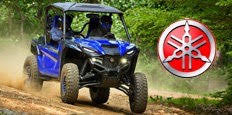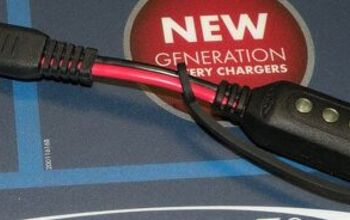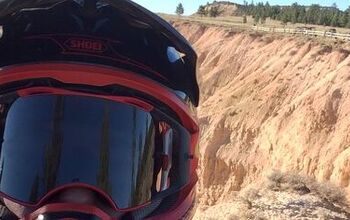Polaris Four Wheelers Lineup Has Something for Every Budget
For the 2019 model year, Polaris four wheelers are available in a wide variety of engine sizes and price points.
Polaris Sportsman Lineup
The flagship of the single-seat Sportsman family is the Sportsman XP 1000, which Polaris boasts is the most powerful ATV on the market thanks to its 952cc, 90-horsepower ProStar Twin engine. Prices start at $11,999. One step down is the 78-horsepower Sportsman 850 ($8,999), followed by the 44-horsepower Sportsman 570 ($6,699) and the value-minded Sportsman 450 ($5,999)
Polaris Sportsman Touring Lineup
When you want to bring along a friend for a ride, the two-up Polaris Sportsman Touring lineup has you covered. Models include the Sportsman Touring XP 1000 ($12,999), Sportsman Touring 850 SP ($11,199) and Sportsman Touring 570 ($7,699).
Polaris Scrambler Lineup
When it comes to more aggressive sport riding, there are a couple Polaris four wheelers to choose from. The big dog is the Polaris Scrambler XP 1000 ($13,299), which shares the same 90-horsepower engine as the Sportsman 1000. The other option is the Polaris Scrambler 850 ($9,799) which much more affordable and still features a 78-horsepower engine.
Polaris Work Machines
Combining the maneuverability of ATVs with the storage of UTVs are two unique Polaris four wheelers – the Polaris X2 570 ($9,799) and the Polaris Sportsman 6×6 570 ($10,999). The X2 offers 1-up or 2-up configuration. The Sportsman 6×6 is set up for a rider and passenger and features six wheels for added cargo capacity. Both machines have a cargo bed in the back.
Polaris ACE Lineup
The Polaris ACE is a newer machine that features the chassis of an ATV with a UTV-like Roll Over Protective Structure (ROPS). Models include the Polaris ACE 900 XC ($12,999), Polaris ACE 570 ($8,999) and Polaris ACE 500 ($6,999).
Youth Polaris Four Wheelers
Youth riders need machines designed for them and Polaris is aggressive in this segment. Polaris Youth models include the Polaris ACE 150 ($3,999), Polaris Sportsman 110 EFI ($3,399), Polaris Outlaw 110 ($3,399) and Polaris Outlaw 50 ($2,299).
A few weeks ago, several industry experts and I sat around bench racing about the industry and talking about new ATVs and UTVs, and who was too late to the party when it came to certain segments. It was widely agreed upon that many companies now are playing catch up to Polaris, who carved out a massive chunk of the market for itself. For those of us old enough to remember, it would seem like the dominance started with Polaris four wheelers, but it goes even further than that, and with a few twists you wouldn’t expect.
Find the Best Deal on Polaris ATV Tires
Polaris, Arctic Cat and Textron
We all know the Minnesota-based company has a strong history with snowmobiles, and if you really don’t know that, climb out from under that rock. The company goes even further back to farm equipment. Two friends – Edgar Hetteen and David Johnson built the company on a foundation of building quality products. Hetteen would eventually be ousted by the board and go on to form fierce competitor Arctic Cat. The focus of the company shifted even further to the snow side and it felt the growing pains associated with a lack of capital. In 1968, a conglomerate came in with the necessary funding and from then until 1980, Polaris was part of a bigger company called Textron. Ever heard of them?
In 1980, Textron wasn’t happy with the snowmobile industry, so the man in charge of the company at the time, W. Hall Wendel Jr., found a backer and sold off Polaris. He then bailed on Textron and took the helm of Polaris’ new-found efforts to exist as a standalone company once more. The problem was, the snow industry was still a little weak. We all know what wasn’t weak in the early 1980s, though – ATVs. In 1985, the first Polaris four wheelers were released. There was even a three-wheeler, named the Scrambler, that barely hit the market before the CPSC shut down three-wheelers and lawsuits flew faster than Superman going to get ice cream for a pregnant Lois Lane.
The First Polaris Four Wheelers
In the 1980s, the big four in the ATV world were all Japanese companies. The engines, transmissions and controls for ATVs were based upon motorcycle technology. Polaris four wheelers had technology based on what Polaris knew best – snowmobiles. Footpegs were replaced by floorboards. Manual-shifting transmissions with clutches were replaced with CVT belt drives and automatic transmissions. Polaris four wheelers were powered by smaller versions of their snowmobile engines and the first were two-strokers, just like the sleds. And a single brake lever operated all four wheels. Crazy stuff.
I remember Polaris being eager to prove itself in competition, too. Several racers lined up in the late 1980s and early 1990s on stripped down Polaris machines, modified to meet the criteria of the completion at the time. The Polaris four wheelers weren’t the best handling machines, but there was no doubting the speed. Polaris knew how to go fast.
In the early 1990s, Polaris introduced the thing that would really set them apart – On Demand all-wheel drive. While Japanese ATVs with 4WD were slower, four-stroke machines with manual shifting, the Polaris four wheelers with AWD were fully automatic machines that added a level of sporty fun to the ride. If you look at what we have today, it’s easy to see who became the leader. By the end of the 1990s, the economy was down, but for the Minnesota company, things were different. Polaris four wheelers held 25% of the market share!
Enter the Sportsman
Today, the Sportsman line is arguably the number-one selling ATV on the market. First introduced in 1996, the first Sportsman was a two-stroke powered machine. That soon gave way to four strokes and the Sportsman 500 was the big kid on the block. That changed in 2001 when the company released the Sportsman 700, the biggest Polaris four-wheeler at the time.
Find the best deal on ATV covers
The 2001 Sportsman 700 started a big-bore war among the manufacturers. Soon machines pushing the displacement envelope started coming from Yamaha, Suzuki, Kawasaki, Honda and Arctic Cat. There was another competitor, Bombardier. Polaris answered with improvements to handling and style, and made things more interesting with the Sportsman 800 a few years later. We all know where this is heading, and a few years ago, we were treated to the Sportsman 1000 – a really fun recreation/utility machine.
Other Fun Polaris Four Wheelers
The current big kid on the Polaris block is the Scrambler XP 1000. This is a rip-snorting, arm stretching recreational machine with superb handling and all-wheel drive. It may well be the fastest Polaris four-wheeler ever produced. But there are challengers to that title.
In the late 1990s, there was a resurrection of Sport ATVs. Every manufacturer got in on the action, with most companies jumping in on the 450-class machines. Polaris went a slightly different route at first. The Predator 500 was a unique machine. Since it didn’t meet the 450-class displacement limits, it really didn’t fit in with what the other manufacturers were doing. By the mid-2000s, the machine everyone was talking about was a KTM that was a screamer. And then an announcement came that floored everyone – Polaris was partnering with KTM. Two new machines came from that union – the Outlaw 450 and the Outlaw 525. The 450 was a little late to the party and couldn’t gain the foothold it needed. The 525 was crazy fast, and even came with independent rear suspension for a couple years. Alas, the partnership ended and the KTM-powered Polaris four-wheelers were no more. The only Outlaw available today is the youth model.
What if a Four-Wheeler and a UTV Had a Baby?
A few years ago, that question was answered when Polaris released the first Ace, a concept of a single-seat UTV with the basic chassis of a Polaris ATV and the steering wheel and seating from a RZR. It’s an interesting machine that has gone on to define its own category in the Polaris lineup.
What will we see next from Polaris four-wheelers? Who knows. They are always innovating, and with stiff competition coming from Can-Am, Textron and the Japanese manufacturers, it’s bound to be good for us.
Derrek's love for all things ATV started when he was a mere 11 years old, growing up on his family farm. His mom gave him and his sister a choice - get a horse, or a three-wheeler. The sister wanted the horse, and Derrek wanted the ATV. Luckily he won out, and was soon burning up the trails on a Yamaha Tri-Moto 200. By the time he was 14, he had saved enough of his own money by working on the farm and in his folks restaurant to buy a new 4-wheeler. That happened the day he and his mom were driving past the dealership and saw 1987 Banshee. His mom had no idea what he was buying, and he never looked back. He's been riding ever since, and been writing professionally for many years. He has ridden all over North America and been behind the controls of just about every machine out there. And yes, he still has his 1987 Yamaha Banshee.
More by Derrek Sigler

















![Pedal Powered Side-by-Side [video]](https://cdn-fastly.atv.com/media/2022/10/24/8744132/pedal-powered-side-by-side-video.jpg?size=350x220)


![Derek Guetter Crashes During Backflip [video]](https://cdn-fastly.atv.com/media/2022/10/24/8744073/derek-guetter-crashes-during-backflip-video.jpg?size=350x220)












